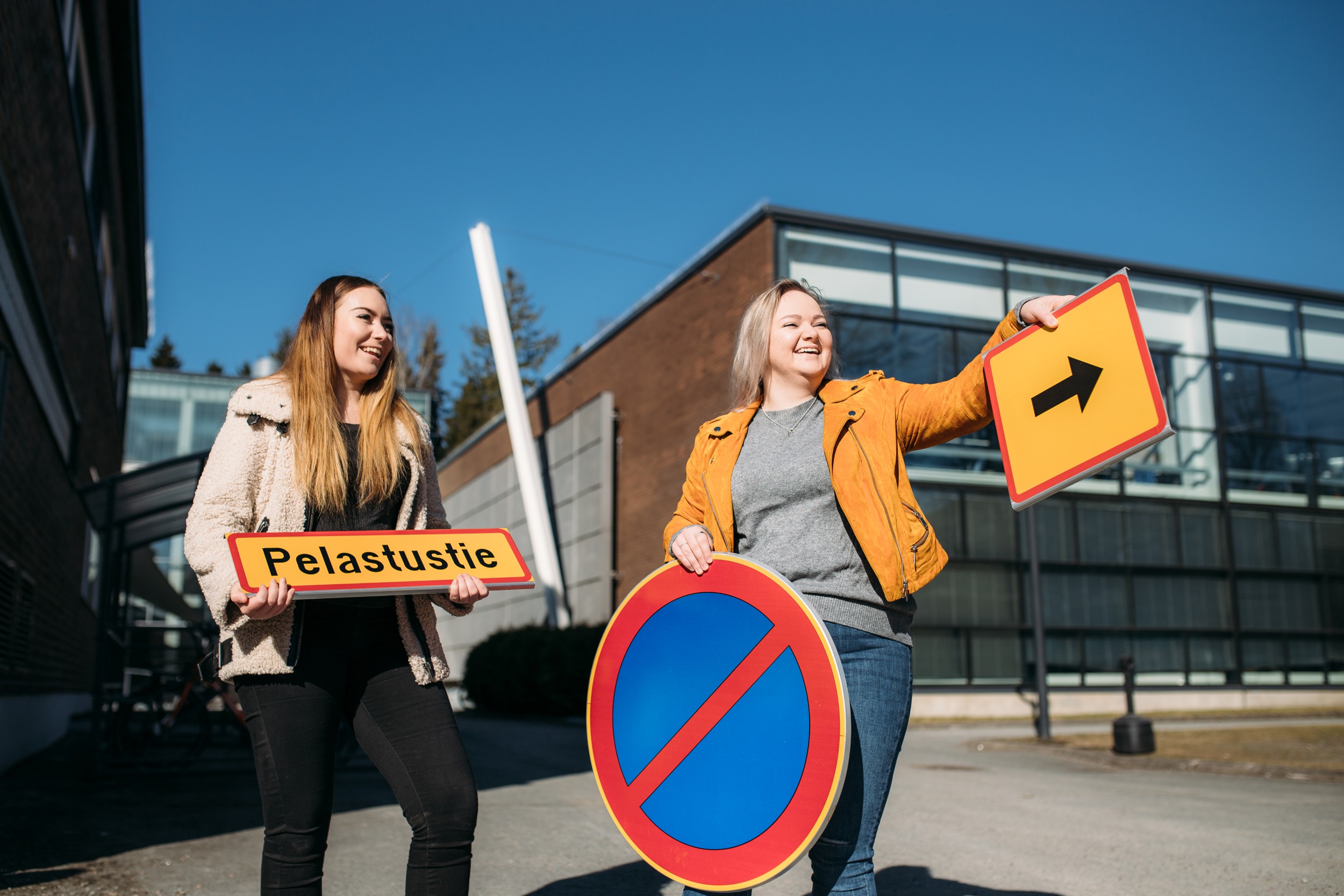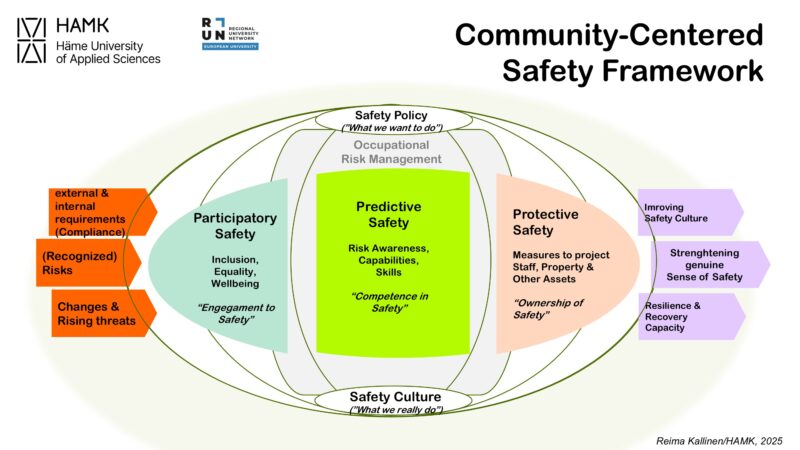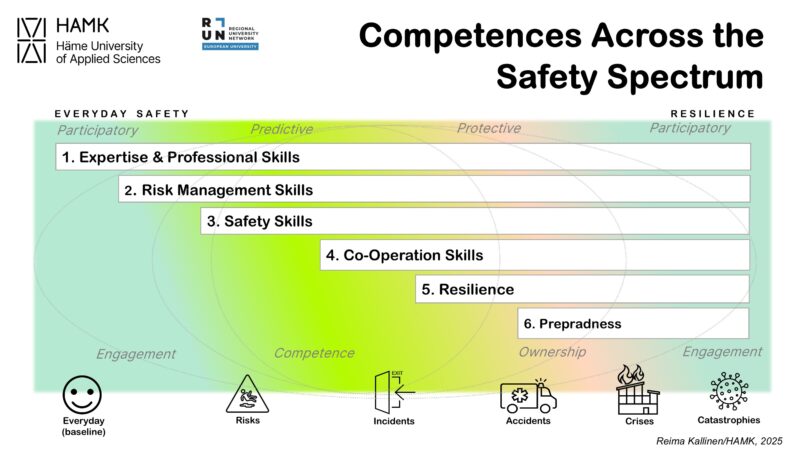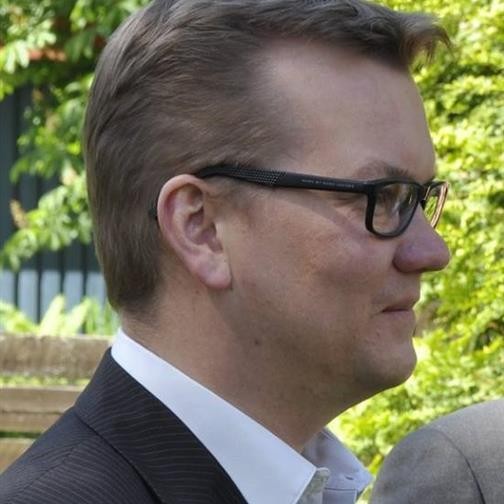
Safe HAMK
Everyday safety and resiliense
The core of our safety work is Community-Centered Safety Thinking. It is an approach that emphasizes the role of the community in promoting and maintaining safety. In this thinking, safety is seen as a shared responsibility of the community, where every member actively participates in improving safety. It is being developed as part of well-being, and it has a strong connection to competence development, work and study well-being, DEIA efforts, and strengthening a sustainable higher education culture.
Read more about community-based safety thinking at the bottom of the page.
Did you notice something?
Immediately report a safety issue when, for example
- if you notice a safety deficiency in a study or work situation
- if you experience a near-miss or threatening situation
- if you experience harassment or inappropriate behaviour
The form is secured and also allows anonymous reporting.
Safer Space Principles
At HAMK, we are committed to following the principles of a safer space in all our activities. These principles are designed to help ensure that every event is a positive and rewarding experience for all participants.
We acknowledge that a space or event cannot always be entirely safe for everyone, and we encourage all members of our community and guests to actively contribute to an atmosphere that promotes safety and well-being. Let’s take care of one another.
Our core principles include:
- We respect each individual’s personal physical and psychological boundaries and do not cross them without consent.
- We avoid assumptions and generalisations, and we honour each person’s individuality and identity.
- We engage in constructive dialogue and ensure everyone has the opportunity to participate. We respect each other’s opinions, experiences, and perspectives. We remain open to new ideas and ask questions with a willingness to learn.
- We listen to feedback and adjust our behaviour if someone expresses discomfort caused by our actions.
- We take responsibility for our own actions and apologise if we unintentionally or intentionally cause harm.
- We always address any observed or experienced harassment, inappropriate behaviour, or threats to safety immediately and offer support in resolving the situation.
If you experience or witness harassment or other inappropriate behaviour during an event that continues despite expressing discomfort, you can contact one of the following:
For students:
- Your degree programme manager
- HAMKO’s harassment contact persons
- Student wellbeing services (study psychologist or student welfare officer)
- HAMK Safety Officer
For staff:
- Your line manager
- Occupational safety representatives
- HAMK Safety Officer
You may also report your experiences or observations confidentially via the Safety Report (link).
HAMK University rules
1. Purpose and scope of the University Rules
1.1. The University Rules were adopted as provided in section 31, subsection 2 of the Universities of Applied Sciences Act (932/2014) to promote internal order, unhindered studying and working as well as safety, security and comfort in the community of Häme University of Applied Sciences (later referred to as HAMK).
1.2. These rules, and also the separately defined principles of a safer space, are valid at all times and apply to everyone on HAMK’s campuses and in online environments, including students, staff and visitors.
1.3. These rules cover the physical campus facilities, including teaching and research facilities and storage buildings, outdoor areas and roads on the campuses as well as virtual facilities, including online learning environments, platforms for communal work, social media channels and other communication channels.
1.4. Where relevant, these rules also apply to study and work situations outside the campus and online services, for example work placements, international exchanges, study visits and representing HAMK.
2. General conduct
2.1. HAMK promotes diversity, equality, inclusion and accessibility in everything it does. The HAMK community members are expected to respect people from different backgrounds, contribute to ensuring equal opportunities and rights for all, and create an inclusive and safe environment.
2.2. Any form of harassment, discrimination and threatening or disruptive behaviour are strictly prohibited and will be addressed immediately. Any such behaviour should always be reported without delay to the staff (students) or a supervisor (staff) either directly or by submitting a safety observation (link).
2.3. Community members must communicate and express themselves respectfully and observe good manners. Internal communication and information channels are used to communicate about matters relevant to studies and work. Discussions on other topics are conducted on channels specifically intended for them.
2.4. A teacher may record image, videos or audio without separate consent for the purposes of work carried out in a module. For more detailed instructions on recording teaching situations, see the Digipedagogical guidelines (link). Students and staff additionally have the right to record material related to teaching or work for their personal use, unless this has been specifically prohibited. When filming, recording and sharing any other material, good practice should be followed and privacy, data protection and information security should be ensured. Consent must be requested for capturing, sharing and publishing material featuring individuals and copyrighted material. This also applies to publishing images on the Internet and social media. Individuals should not be photographed or filmed unnecessarily.
2.5. In situations involving verification of identity (including examinations), the face of the person to be identified must be visible. Identity checks should be carried out respectfully and following good practice.
3. General safety, security and order
3.1. Every member of our community has a duty to promote its safety and security. All community members must comply with the safety guidelines and, where possible, promote general safety and security both on the campuses and in online environments.
3.2. In situations that put human life and health at risk and in other emergencies, emergency number 112 should always be called. In emergencies, community members must follow instructions issued to them and the rescue plan as well as ensure their personal safety and the safety of others.
3.3. Any identified safety deficiencies, hazards and risks must be addressed without delay and, where possible, remedied immediately. The issue must be reported to the person or unit responsible for it or, if not known, to the staff (students) or a supervisor (staff), either personally or by submitting a safety observation (link).
3.4. Illegal objects or substances must not be brought to HAMK’s premises and campus areas without an acceptable reason. In particular, possession of hazardous objects that could be used as a weapon is prohibited in principle without an appropriate reason, such as performance of a task related to studies or work or other acceptable purpose of use.
3.5. Staff members must participate in safety training, exercises and other safety events organised for them, including safety walks and evacuation exercises, and follow safety-related communication on HAMK’s information channels.
3.6. A supervisor must ensure that the level of their team’s safety competence and equipment are sufficient for their tasks and work environment as well as engage the team in discussions and create a shared understanding of safety issues and changes relevant to them. If necessary, the supervisor must launch systematic efforts to improve safety capabilities.
3.7. Students must participate in safety exercises and training organised for them, unless there is an acceptable reason for being absent, including health-related or other weighty reasons. When organising exercises and training, potential stress affecting the participants’ mental well-being must always be taken into consideration.
3.8. The building and safety technical equipment or safety arrangements of the premises, including air conditioning, locks, fire alarms or escape routes, may not be disabled or altered without the permission of HAMK’s facilities management and services. The escape routes and emergency access roads of buildings must be kept clear at all times, and any obstacles must be removed from them immediately.
3.9. The staff must keep their HAMK ID cards visible during working hours unless this interferes with or poses a risk to the performance of their tasks. A supervisor must ensure that everyone in their team has an up-to-date staff ID card. In the interest of security, ID cards may not be carried together with keys or access control tags (see section 4.3). When the employment relationship ends or the card information changes, the ID card must be returned to HR Services without delay.
3.10. Attending teaching or working while intoxicated is prohibited. Disruptive behaviour caused by intoxication will be addressed immediately. Valid alcohol legislation and official guidelines will be complied with at any events on the campus where alcohol is served.
3.11. We have zero tolerance for the use, possession and peddling of drugs on our campuses. Such activities will be addressed immediately, however without putting anyone’s safety at risk. If direct intervention is not possible, a safety observation (link) should be submitted. All drug-related matters will also be reported to the police.
4. Facilities and equipment
4.1 HAMK’s facilities, equipment and services are primarily intended for studying, conducting research and performing other tasks associated with the higher education institution’s operation. Their use for other than the intended purposes without permission is prohibited. All community members should make sure that the facilities are used appropriately and carefully, ensuring their tidiness and comfort.
4.2. Camping on HAMK’s campuses and staying overnight in its facilities not intended for this purposes or in their outdoor areas without separate permission are prohibited.
4.3. The staff and students must keep their keys and access control tags carefully and following the instructions issued. Keys must not be attached to key rings with organisation IDs or other identifiable items, including HAMK lanyards or marketing key rings that may indicate the premises they are used to access. Unwanted keys and access control tags, or ones no longer associated with access rights, must be returned without delay to persons responsible for key management on the campus or facilities management and services.
4.4. No unidentified persons may be allowed to enter unescorted the facilities for which a special key or access control tag is required, or which are locked outside opening hours. To verify their identity, staff members, students or visitors seeking to enter the premises may be asked to show a HAMK ID card, student card or other proof of their right to access the facilities. Visitors must be invited or received by a designated person (see section 5.4).
4.5. HAMK’s facilities, equipment and other property must be handled responsibly and with care, ensuring that they remain functional and safe. Anyone damaging the premises or property deliberately or through negligence will be liable for the damage and subject to potential disciplinary action.
4.6. If necessary, HAMK may place security steward(s) in its facilities when, under the law, this is justified in order to maintain public order, safety or security.
4.7. Any faults, deficiencies or misuse of the facilities or their building services equipment, including electricity, lighting, air conditioning or water supply, must be reported immediately using the KiPiNet system (link).
4.8. HAMK accepts no responsibility for private property, valuables and money in its area. Lost property recovered in the facilities and campus outdoor areas will be treated as property found in a public place. Such property will be kept for 6 months (excluding perishable or clearly unusable items). After this period any lost property, other than items of low value, will be delivered to the lost property office of the nearest police department.
4.9. HAMK’s information systems, IT devices, telecommunications connections and other IT resources must be used responsibly for studying, teaching, research and other activities of the higher education institution. They must be used in compliance with HAMK’s information security policy, rules for IT equipment use and other IT instructions (link). Each HAMK community member is responsible for their user ID as well as information security and data protection. Any risks and deviations observed must be reported to HAMK’s Digital Services Helpdesk (link).
5. Visitors and the campus as a public space
5.1. HAMK campuses are open to visitors during normal opening hours. The basic principle of our community is respectful and friendly behaviour, and we also expect it of our visitors.
5.2. Disruptive and/or inappropriate behaviour on our premises and campuses will always be addressed. All visitors have a duty to comply with the valid rules and instructions for safety and premises use, and these rules must be made clear to visitors without delay where necessary.
5.3. Events of political, religious and otherwise ideological nature organised by third parties and the distribution and presentation of materials pertaining to such ideologies are only permitted with the permission of HAMK’s management. Prior notice must be given of any public meetings organised in the facilities or campus areas, including demonstrations, to ensure the participants’ safety and to prevent unreasonable inconvenience to HAMK or damage to its property.
5.4. Accessing premises that are kept locked outside opening hours and facilities subject to access control at all times is only possibly with keys or access control tags that are assigned to a specific person and may not be handed over to others. Visitors entering the facilities are always the responsibility of the person who has invited or receives them (see section 4.4).
5.5. Our visitors can also inform the staff of their safety observations or submit a safety observation (link).
6. Procedure for violations of the University Rules and penalties
6.1. Any violations of these rules that come to light will be addressed without delay. All violations will be handled on a case-by-case basis, and penalties will be determined based on their seriousness.
6.2. To ensure open, smooth and fair processing, any observed violations should be reported to the Head of Degree Programme or a supervisor, preferably in person. Alternatively, a safety observation (link) can be submitted, also anonymously. Anonymous reports will mainly be handled as tips, and other evidence must be obtained before decisions on any further action are made. All reports will be handled confidentially.
6.3. Reports intentionally containing untrue information will always be regarded as harassment. Submission of such reports may also constitute some other offence, including defamation or persecution.
6.4. The procedure and penalties for students are specified in detail in the degree regulations (link). For the staff, penalties will be determined in compliance with the Employment Contracts Act. If a visitor violates these rules we can take the necessary action, including intervention in the violations, preventing them, or asking a visitor to leave the campus.
6.5. If a violation of these rules meets the characteristics of an offence, it will also always be reported to the police.
7. Entry into force and updates
7.1. These rules were discussed by the cooperation group 1 April, 2025 and adopted as a HAMK guideline by the Quality and Risk Management group 26 May, 2026. These rules will come into effect on June 16, 2025.
7.2. HAMK reserves the right to modify and update these rules when necessary. Information on any modifications will be provided on HAMK’s communication channels. All community members have a duty to keep themselves informed of the valid University Rules.
Emergency and safety plans for campuses
The campus emergency and safety plans provide instructions for various emergency and exceptional situations. Familiarize yourself carefully and regularly with your campus’s emergency plan.
Safety instructions
Emergency number 112
First aid
Fire
Bullying and harrasment
Community-Centered Safety Thinking
The key principles of the Community-Centered Safety Thinking are:
Everybody’s Business
- Shared Responsibility: Everyone has the duty and right to contribute to the safety of our community.
- Active Participation: Encourage all members to actively engage in safety initiatives and practices.
- Empowerment: Provide individuals with the knowledge and tools they need to contribute to a safe environment.
Community and Inclusion
- Well-being and Togetherness: Safety work supports the well-being of the community and promotes a sense of togetherness.
- Inclusive Safety Efforts: Every member of the community has the right and duty to promote safety.
- Skill Development: Community safety skills are developed through activities like safety walks and drills.
Proactive Action
- Risk Identification and Mitigation: The goal of safety work is to identify, prevent, and mitigate safety risks to the community and its members.
- Risk Management: Proactive safety includes risk management and understanding the operational environment.
- Crisis Preparedness: Preparedness for various disruptions and crisis situations is emphasized.
Safety Culture
- Everyday Safety: Building a strong safety culture where safety is part of everyday life.
- Continuous Improvement: Continuous learning and improvement are integral to the safety culture.
- Metrics and Reporting: Safety culture metrics include incident and observation reports, as well as safety walks.
Training and Competence Development
- Ongoing Training: Strengthening the safety competence of the staff and students through continuous training and practicing.
- Comprehensive Skills: Staffs’ safety competence includes general and task-specific orientation, risk management, information and cyber security, as well as first aid, basic fire extinguishing, and evacuation skills.
- Role-Specific Training: The competence of supervisors and campus safety groups is developed through role-specific training.
Resilience
- Recovery Ability: The community’s ability to recover from disruptions and crises is a key part of safety thinking.
- Strengthening Measures: Resilience is strengthened through protective and proactive measures.
- Comprehensive Capabilities: Safety capabilities include professional skills, risk management competence, safety competence, collaboration skills, and resilience.
Safety work at HAMK is constructed and implemented with three focus areas: Participatory, Predictive, and Protective safety. These focuses are used as perspectives to solve safety and security issues, making them more sustainable, adaptable, and flexible for both the systems and the people of the community. The core of the safety work lies in occupational risk management, and the main outcome is a genuine sense of safety.

Another key aspect of our safety work is concentrating on enforcing safety competencies. The previous model with three core focus areas acts as a sort of engine that is then used to create competencies that strengthen everyday safety, risk management, emergency capabilities, and the resilience of individual staff members and the whole community. This also provides a basis for a strong safety culture and a positive safety attitude, ensuring a safe environment for our students, cooperative partners, and guests.

Contact us
Each of our campuses has its own security team. HAMK’s security work is planned and developed by the Group Security and Preparedness Group, which consists of the chairs of the campus security groups.



tERHI nOPANEN
Head of education / horticulture and forestry
terhi.nopanen@hami.fi
+358504641607






tERHI nOPANEN
Head of education / horticulture and forestry
terhi.nopanen@hami.fi
+358504641607


Kaunisto Jyri
head of education / Food Industry, agriculture
+358505745131
jyri.kaunisto@hami.fi


Jyrki Hapulahti
Senior Lecturer
jyrki.hapulahti@hami.fi
+358408338211

Kaunisto Jyri
head of education / Food Industry, agriculture
+358505745131
jyri.kaunisto@hami.fi
